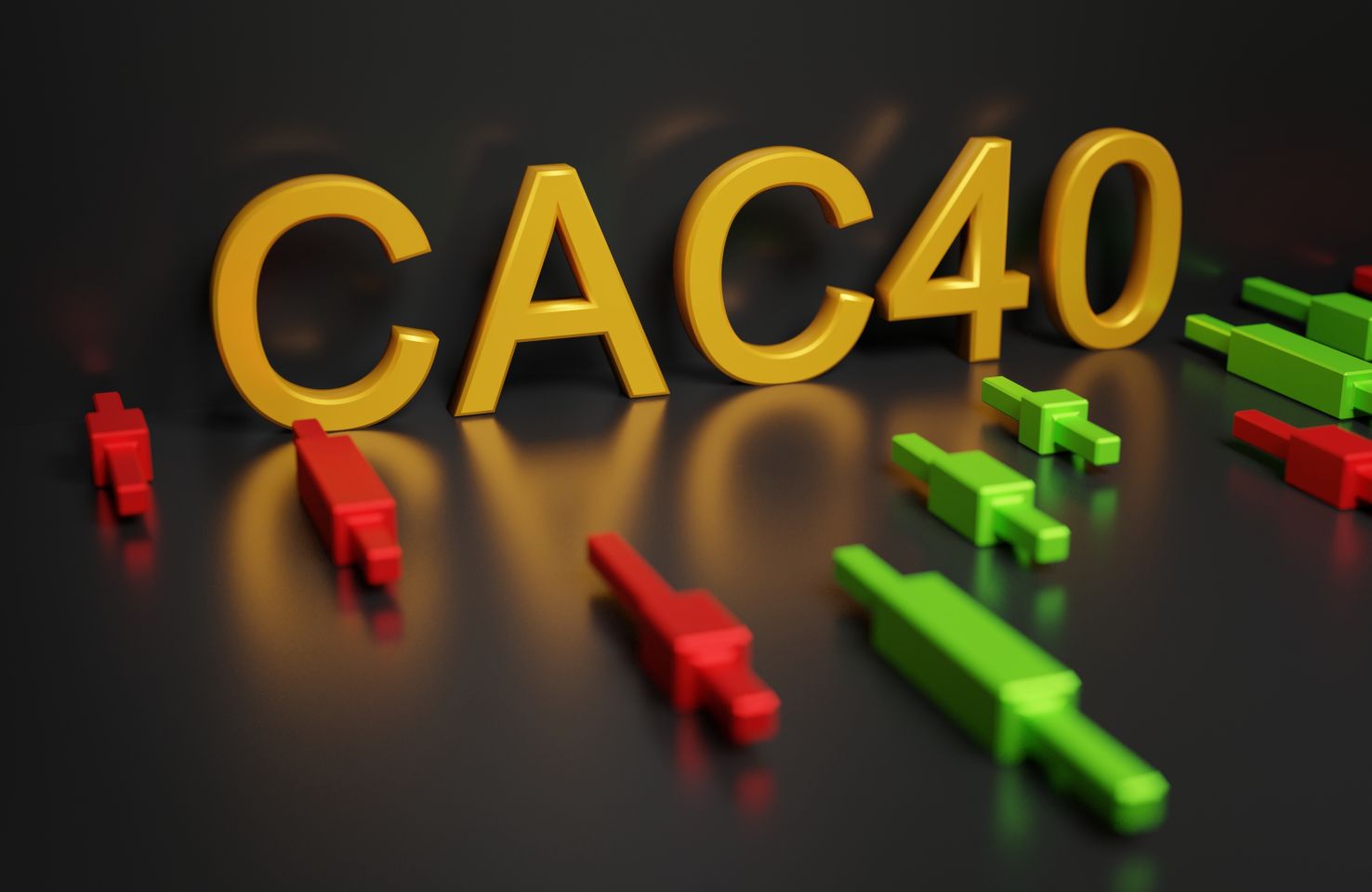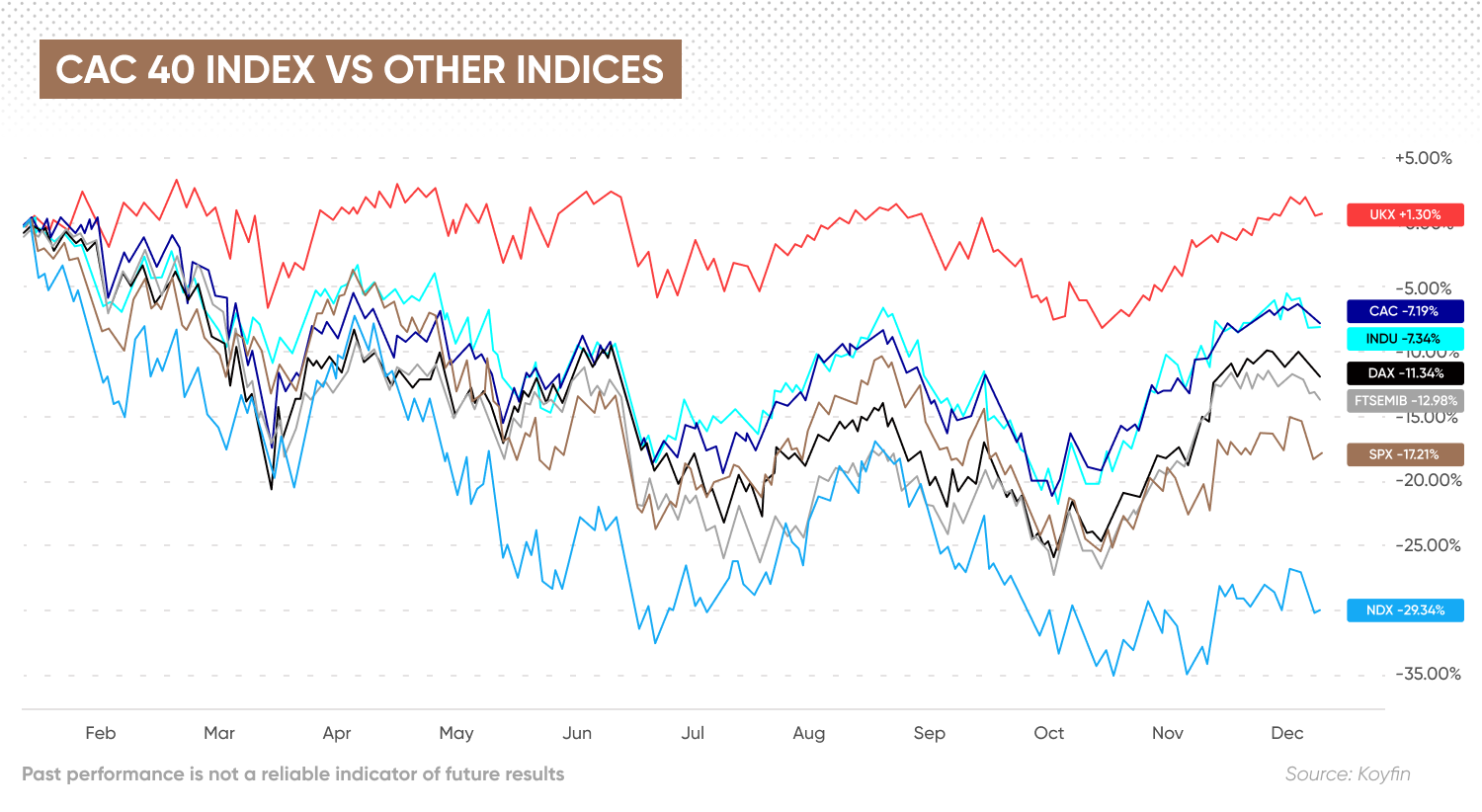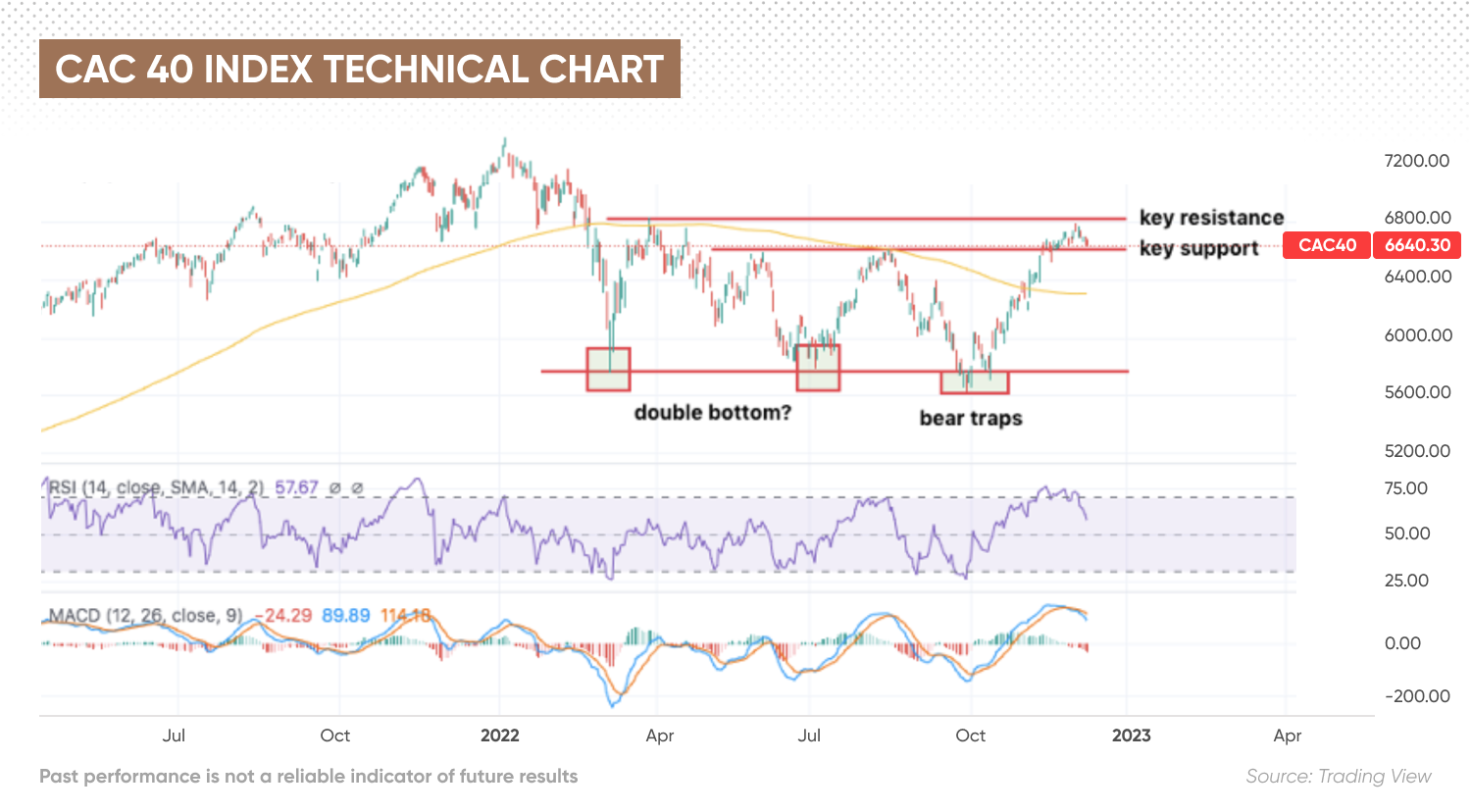CAC 40 forecast: Is the French index poised to outperform its peers?
The CAC 40 index is made up of the 40 largest companies on the Euronext Paris exchange
The price of the CAC 40 Index (FR40) has declined 7% so far this year amid deteriorating macroeconomic conditions and rising inflation in many regions, including the European region.
Additionally, the energy crisis caused by Russia’s hostile actions against Ukraine has increased fears that Europe may be poised to enter a cycle of slower or even negative growth.

That said, the index is outperforming some of its regional peers and top US benchmarks like the S&P 500 (US500) and the US Tech 100 index (US100).
Can this positive performance continue? In this CAC 40 forecast, we assess the index’s historical price trend and its prospects to outline plausible scenarios for the future.
What is the CAC 40 Index?
CAC 40 (FR40) live chart
The CAC 40 index is a benchmark made up of the 40 largest companies by market capitalisation that are listed on the Euronext Paris exchange. This index is considered by investors as the most representative for tracking the overall performance of the equities market in France.
As of 30 September, French conglomerate LVMH Moët Hennessy Louis Vuitton was the most heavily weighted company in the CAC 40, making up for 11.73% of its price. The index’s top 10 holdings account for 58.1% of its price and performance, meaning that this is a heavily concentrated equity benchmark.
At the time of writing on 8 December, the top 10 holdings making up the CAC 40 index are:
|
Rank |
Company name |
Ticker |
Market cap |
Country |
|
1 |
LVMH Moët Hennessy Louis Vuitton |
MC |
$379bn |
France |
|
2 |
TotalEnergies |
TTE |
$154.71bn |
France |
|
3 |
Sanofi |
SNY |
$119.14bn |
France |
|
4 |
L'Oréal |
OR |
$200.45bn |
France |
|
5 |
Schneider Electric |
SU |
$81.00bn |
France |
|
6 |
Air Liquide |
AI |
$76.43bn |
France |
|
7 |
Airbus |
AIR |
$91.51bn |
Netherlands |
|
8 |
BNP Paribas |
BNP |
$67.68bn |
France |
|
9 |
Vinci |
DG |
$58.26bn |
France |
|
10 |
EssilorLuxottica |
EL |
$83.67bn |
France |
The consumer discretionary sector holds the most weight on the index with 28.5%, followed by industrials (21.3%) and healthcare (10.8%).
Since the start of the year, the worst-performing sector has been technology (-20.2%) followed by real estate (-17.5%). The best performing sector in 2022 was energy (26.7%) followed by healthcare (2.3%).
It is worth noting that the vast majority of the index’s sectors are in negative territory so far in 2022.
The best performing sub-sector is oil & gas with yearly gains of 26.7% gains, followed by aerospace & defence, up 10.2%. Finally, the worst performing sub-sector is professional and commercial services with a 41.2% annual loss.
Thales (HO) leads the scoreboard among this year’s winners with a 61.1% upside, followed by TotalEnergies and Renault (RNO) with annual gains of 26.7% and 13%, respectively.
Leading the losers is Teleperformance with a 42.4% accumulated loss in 2022, followed by Eurofins Scientific and Dassault Systemes with year-to-date (YTD) losses of 39.9% and 33.3%, respectively.
Notably, the stock of LVMH, the company with the highest weight in the index, has retreated by just 2% this year, which has contributed to cushioning the losses the index has experienced despite a relatively uncertain macroeconomic and geopolitical backdrop.
Since the top five holdings of the index account for nearly 40% of its value and performance, investors can focus on analysing the current situation and prospects of these five companies to draft a plausible CAC 40 forecast.
CAC 40 predictions: Technical views and price drivers

The chart above shows that the value of the CAC 40 Index reached all-time highs in January this year but has been on a downtrend since then as macroeconomic conditions across the globe and hostilities between Russia and Ukraine have weighed on its performance.
That said, the performance of the index trimmed its losses from around 17% in late September to 7.2% as of 8 December as France’s gross domestic product (GDP) expanded by 0.5% during the second quarter, having retreated by 0.2% during the first three months of the year.
From a technical perspective, a double-bottom pattern appears to have formed during the first six months of the year as the CAC 40 bounced off 5,775 in March and July.
Double bottoms are considered bullish price action signals that could indicate an upcoming increase in the value of the asset at hand. Right after the pattern formed, the index rallied to 6,600 – a key resistance level. Shortly afterward, it posted a sharp decline and retested the 5,775 support but bounced off after a couple of bear traps.
For now, the 6,600 resistance has been broken. This level has now turned into support and remains the most important one to watch moving forward. Moreover, if the 6,800 resistance is broken, the odds may be in favour of further upside ahead for the CAC 40 index.
Key drivers to consider for a CAC 40 Forecast
As of 8 December, France’s GDP was expected to grow by 2.6% this year, according to estimates from the European Commission (EC). However, the economy was expected to grow at a much slower pace of 0.4% next year and 1.5% in 2024 as several headwinds, including high inflation and historically-high energy prices, could weigh on the nation’s economic activity.
According to the EC, inflation was expected to remain high in 2023 at 4.4%. However, this annual advance would be lower than that of 2022. Prices were expected to climb at a much slower pace in 2024 with inflation forecasts from the EC sitting at 2.2% for that year.
The hostility between Russia and Ukraine is a key factor to analysing as well drafting a CAC 40 forecast. An escalation in the armed conflict that involves the direct participation of France or other countries within the region may lead to further deterioration of the macroeconomic backdrop.
Finally, the state of the energy market could have a strong influence on the performance of the index. Any indications that natural gas and oil prices will continue to increase may lead to revisions to the country’s forecasted economic growth that could depress the value of companies based in France.
CAC 40 prediction: Algorithm-based forecasts
As of 8 December, Wallet Investor held a mildly bullish short-term outlook on the CAC 40 index. The price was expected to rise by 0.4% within the next 14 days to 6,674.
The algorithm-forecaster predicted the price could continue to rise in the next few years. The following is a detailed list of the algorithm’s forecasts for the end of December 2022 and November 2025. There was no CAC 40 forecast for 2030 available.
CAC 40 forecast 2023: 7,305.
CAC 40 forecast 2025: 8,422.
On the other hand, the baseline short-term CAC 40 forecast from Gov Capital was also bullish, predicting that the price could rise to 6,866 within the next 14 days, based on an analysis of the index’s historical trend.
The mid-term outlook is also positive. tThe index is expected to climb to 11,395 a year from now, implying a 71.9% gain within that period. The following are CAC 40 predictions for the end of December for 2022 and 2025.
CAC 40 forecast 2023: 11,514.
CAC 40 forecast 2025: 26,107.
None of these CAC 40 predictions or the opinions and comments expressed in this article should be taken as a recommendation to invest in the index. Investors are encouraged to perform their own due diligence before making any investment decision. Past performance is not a guarantee of future results. And never invest money you cannot afford to lose.
FAQs
Is CAC 40 a good investment?
The CAC 40 index is a broad-market benchmark that tracks the value of 40 securities listed on the Euronext Paris exchange. The performance of this business is primarily influenced by how the European economy is doing. Investors must evaluate the prospects of this region to determine if it is a good time to invest in the index.
Investors are encouraged to perform their own due diligence before making any investment decision. Past performance is not a guarantee of future results. And never invest money you cannot afford to lose.
Will CAC 40 go up or down?
No-one can know for sure. According to estimates from both Wallet Investor and Gov Capital, the CAC 40 index could rise in the short, mid and long terms. However, these estimates must not be considered a recommendation to invest in the benchmark. They are drafted based on an analysis of the index’s historical performance and price trend. Past results are not a guarantee of future performance.
Should I invest in CAC 40?
The decision to invest in the CAC 40 index should only be made upon considering the investor’s unique risk tolerance, financial goals, income, employment, and other similar factors. Always conduct your own due diligence, looking at the latest stock news, a wide range of analyst commentary, technical and fundamental analysis.
Remember, past performance does not guarantee future returns. And never trade with money you cannot afford to lose.